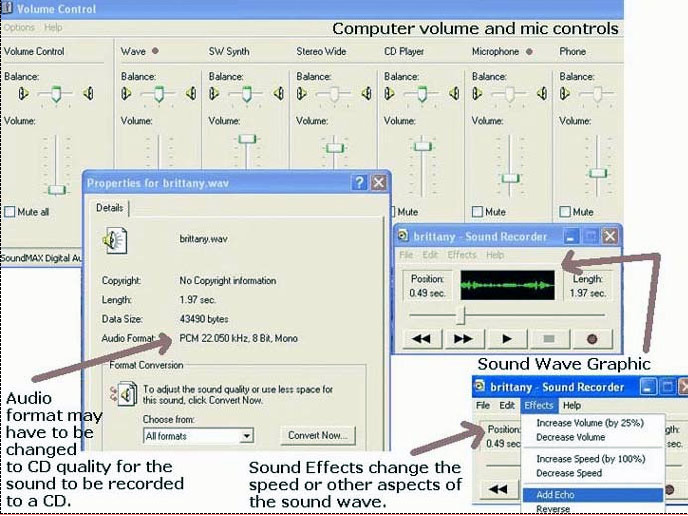Lesson Plans Page
Print this Lesson PDF (248 KB)
A student favorite is the 'Experimenting with Sound Waves' Lesson. They will ask to do this again and again.
Lesson 005
Objectives:
*Students will continue to expand their own composition (ABA song form)
using the notes in the C Major
Scale, and the keyboard and sequencing software on the computer to
playback the song.
*To
complete pp. 20-32 in the Alfred Basic Piano Library Level 1A
(varies based on student level).
*To complete one or more Lessons in Music Ace 1.
*To complete one or more quizzes on our web site and report scores to the
teacher.
*To complete a brief study on sound waves and applications.
Materials:
Alfred 1A Piano Books,
keyboards and related equipment, computers (with or without Internet
access), printer, Sibelius or Music Time Deluxe and Music Ace 1 software
and teacher's manual, computer microphones, CD-R disks.
Procedures: Students
should learn what a sound wave is and how it is used in computer
applications. Follow
this link to review brief definitions. Notice the
sound wave lesson graphics below. Students will use a microphone
to record their voices into the Sound Recorder program on a
Windows computer. Adjust the volume as needed. Let the student
experiment with the sound wave by pressing 'Effects' and 'Echo,
Reverse, Increase and Decrease Speed'. The student should save
their work in My Documents. Explain to the students how the
digital version of their voice, the sound waves, are produced
and recorded to CD's. Many times, the teacher will have to
change the 'Properties' of the sound wave to CD quality audio
format in order for it to be recorded to a CD-R disk. If time
is available, record the voices to a CD and play it back in
a regular audio CD player. Tell the students about the differences
in MIDI and sound wave files. MIDI files have to be converted
to sound waves using a mixer and other instrument, such as
a keyboard, to record the file as a sound wave into the computer
before it can be recorded to a CD.
Wave - (Waveform) - The shape of a sound produced by an oscillator that determines the timbre of the sound. Waveforms include sine, pulse, sawtooth, square and triangle waves. (Sound Wave) - the shape of a sound, which can be described by showing it on a graph. When something vibrates, variations in air pressure create vibrations and are transmitted as a sound wave. Different sounds have different shaped waves.
Ask students to notice...
* What kinds of 'shapes' are made with the digital form of their voice on
the computer?
* Does your voice sound different than you think it does when you are speaking?
* Does the sound wave that you made look like the sound waves that other
students made? Why?
* What are your favorite 'effects' for changing your sound wave?
* What happens when you speed up / slow down the sound wave?
* Can a MIDI sound file be recorded to a CD like a digital sound wave?
* Are sound waves larger in file size than MIDI files?
* Can you find the starting point and ending point of your voice on the
sound wave graphic?
Demonstration of sound wave recorded by a student (first name only - our waves were longer than what you hear on this site).


